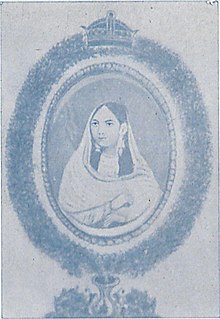Lutfunnisa Begum (Persian: لطف النساء بیگم, Bengali: বেগম লুৎফুন্নেসা; 1740 – 10 November 1790) was the 3rd wife and primary consort of Siraj ud-Daulah, the last independent Nawab of Bengal (the ruler of the Bengal Subah).[1]
| Lutfunnisa | |
|---|---|
 Portrait of Lutfunissa from Banglar Begum (1912) | |
| Consort of the Nawab of Bengal, Bihar and Orissa | |
| Tenure | 9 April 1756 – 23 June 1757 |
| Born | 1740 |
| Died | 10 November 1790 (aged 49–50) Murshidabad, Bengal Presidency |
| Burial | |
| Spouse | Siraj ud-Daulah |
| Issue | Qudsia Begum Sahiba (Umme-Zehra) |

Early life
editLutfunnisa, originally named Rajkunwari, was a Brahmin girl who served Begum Sharifun nissa, Siraj ud-Daulah's maternal grandmother.[2] Siraj was infatuated with the beauty of Rajkunwari and asked his grandmother to give her to him. Begum Sharifun nissa complied and he renamed her Lutfunnisa Begum. By this point, Siraj had already married two other wives: Begum Zaibunissa and Umdatunnisa Bahu Begum.[3]
Life after marriage
editLutfunnisa gave birth to a daughter, Umme Zohra Begum, who was Siraj's firstborn child. In 1748, Siraj's father, Zain ud-Din Ahmed Khan, was killed by Afghan rebels headed by Mustafar Khan. Siraj was also appointed to his father's former position of Naib Nazim of Bihar. During this time, Lufunnisa Begum became his primary consort. After the Battle of Plassey, which saw the British East India Company defeat Siraj and his French allies, Lutfunnisa escaped the palace with him and their daughter. Accompanying them was a trusted eunuch. On 24 June 1757, they made their escape. They were soon captured and brought back to Murshidabad by Mir Jafar, the new nawab allied with the British.
Siraj-ud-Daulah was executed on 2 July 1757 in Murshidabad.[4] Mir Qasim, the son-in-law of Mir Jafar, tortured Lutfunnisa to discover the locations of the family jewels.[3] Soon after the killing of Siraj, all of the women of the house of his maternal grandfather, Alivardi Khan, were either poisoned or rowed out into the centre of the Hooghly river and drowned by sinking of their boat.[4] The only ones who were spared were Lutfunnisa and her daughter, who in 1758, were exiled to Dhaka and imprisoned in Jinjira Palace. She was confined there for seven years[citation needed] during which time Mir Jafar and his son each asked for her hand in marriage. She refused, stating, "having ridden an elephant before, I cannot now agree to ride an ass".[4]
She was released from Jinjira Palace in 1765 and was allowed back to Murshidabad. The British East India company allowed the creation of a pension for her and her daughter. The latter, Umme Zohra Begum, was married to Mir Asad Ali Khan Murad ud-Doulah, the nephew of Siraj, son of Mirza Mehedi Ekram ud-Doulah and later nawab of Dhaka. After her marriage, Umme Zohra Begum was renamed as Qudsiyah Begum Sahiba. They would give Lufunnisa four grandchildren, whom she raised after the death of first her son-in-law and then her daughter in 1774. In March 1787, she petitioned the British East India Company to increase her pension so to meet the additional cost of four grandchildren. The company refused the increase. The Estate of the Nawab of Bengal still paid for the upkeep of Lufunnisa's father-in-law's grave, which was managed by her.[3][5] Lutfunnesa would personally visit the mausoleum in the afternoon with recitations from the Quran every day and light candles there.
Death
editLufunnisa died on 10 November 1790. She was buried in Khushbagh by the side of her husband.[3]
In popular culture
editIn 1960 the Indian novelist Sree Parabat published a novel, Ami Sirajer Begum, about the life of Lutfunnisa and Siraj-ud-Daulah. In 2018–19 an historical soap opera based on the novel, and also called Ami Sirajer Begum, was broadcast on Star Jalsha, in which Lutfunnisa was portrayed by Pallavi Dey.
References
edit- ^ "The women in Siraj ud-Daulah's life". The Daily Star. 4 October 2012. Retrieved 6 November 2017.
- ^ Markovits, Claude (2004). A History of Modern India, 1480–1950. Anthem Press. ISBN 9781843310044.
- ^ a b c d Iqbal, Shahryar ZR. "Lutfunnisa Begum". Banglapedia. Retrieved 6 November 2017.
- ^ a b c Dalrymple, William (2019). The Anarchy: The Relentless Rise of the East India Company. London: Bloomsbury Publishing. pp. 132, 133. ISBN 978-1-63557-395-4.
- ^ "Jinjira Palace: A tale lost in time". Prothom Alo. Archived from the original on 7 November 2017. Retrieved 6 November 2017.